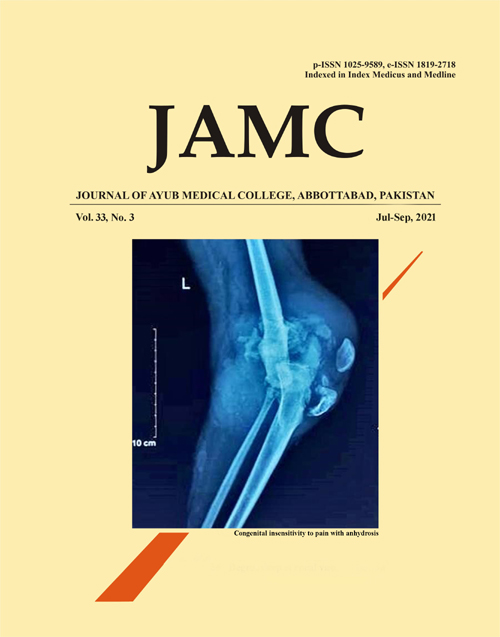IMPLANTATION OF THE PERMANENT PACEMAKER; FROM SUPERIOR VENA CAVA IN A PATIENT WITH FIBROSIS OF BOTH SUBCLAVIAN VEINS
Abstract
Overall life span has increased with improved management of cardiac diseases all over the world which has opened the door of degenerative cardiac diseases. On the other hand, stat of the art corrective congenital cardiac disease also increased the volume of adult living with treated congenital heart diseases. Both these factors lead to a new epidemic in cardiology of complete heart block (CHB). Permanent pacemakers (PPM) implantation is a life-saving procedure for CHB. Permanent pacemakers are usually implanted from upper limb veins. But at time upper limb veins are not suitable for implantation due to various anatomical and pathological reasons, so alternative methods are used for implantation of devices. We are reporting a case of PPM implantation from Superior Vena Cava (SVC).
References
O'Leary B, Allaqaband S. Subclavian Vein Stenosis/Occlusion Following Transvenous Cardiac Pacemaker and Defibrillator Implantation: Incidence, Pathophysiology and Current Management. J Patient-Centered Res Rev 2015;2(3):112-7.
Migliore F, Curnis A, Bertaglia E. Axillary vein technique for pacemaker and implantable defibrillator leads implantation: a safe and alternative approach? J Cardiovasc Med (Hagerstown) 2016;17(4):309-13.
Kircanski B, Vasic D, Savic D, Stojanov P. Low incidence of complications after cephalic vein cutdown for pacemaker lead implantation in children weighing less than 10 kilograms: A single-center experience with long-term follow-up. Heart Rhythm 2015;12(8):1820-6.
Filippi L, Vangi V, Murzi B, Moschetti R, Colella A. Temporary epicardial pacing in an extremely low-birth-weight infant with congenital atrioventricular block. Congenit Heart Dis 2007;2:199-202.
Ellestad MH, Caso R, Greenberg PS. Permanent pacemaker implantation using the femoral vein: a preliminary report. Pacing Clin Electrophysiol 1980;3(4):418-23.
Mathur G, Stables RH, Heaven D, Ingram A, Sutton R. Permanent pacemaker implantation via the femoral vein: an alternative in cases with contraindications to the pectoral approach. Europace 2001;3(1):56-9.
Cohen SI, Smith LK, Aroesty JM. Transfemoral cardiac pacing and phlebitis. Circulation 1974;49(5):1018-9.
Barakat K, Hill J, Kelly P. Permanent transfemoral pacemaker implantation is the technique of choice for patients in whom the superior vena cava is inaccessible. Pacing Clin Electrophysiol 2000;23(4 Pt 1):446-9.
GarcÃa Guerrero JJ, Fernández de la Concha Castañeda J, Doblado Calatrava M, Redondo Méndez Ã, Lázaro Medrano M Transfemoral access when superior venous approach is not feasible equals overall success of permanent pacemaker implantation. Ten-year series Pacing Clin Electrophysiol 2017 Jun;40(6):638-643.
Poole JE, Gleva MJ, Mela T, Chung MK, Uslan DZ, Borge R, et al. Complication rates associated with pacemaker or implantable cardioverter-defibrillator generator replacements and upgrade procedures: results from the REPLACE registry. Circulation 2010;122(16):1553-61.
Rozmus G, Daubert JP, Huang DT, Rosero S, Hall B, Francis C. Venous thrombosis and stenosis after implantation of pacemakers and defibrillators. J Interv Card Electrophysiol 2005;13(1):9-19.
Downloads
Published
How to Cite
Issue
Section
License
Journal of Ayub Medical College, Abbottabad is an OPEN ACCESS JOURNAL which means that all content is FREELY available without charge to all users whether registered with the journal or not. The work published by J Ayub Med Coll Abbottabad is licensed and distributed under the creative commons License CC BY ND Attribution-NoDerivs. Material printed in this journal is OPEN to access, and are FREE for use in academic and research work with proper citation. J Ayub Med Coll Abbottabad accepts only original material for publication with the understanding that except for abstracts, no part of the data has been published or will be submitted for publication elsewhere before appearing in J Ayub Med Coll Abbottabad. The Editorial Board of J Ayub Med Coll Abbottabad makes every effort to ensure the accuracy and authenticity of material printed in J Ayub Med Coll Abbottabad. However, conclusions and statements expressed are views of the authors and do not reflect the opinion/policy of J Ayub Med Coll Abbottabad or the Editorial Board.
USERS are allowed to read, download, copy, distribute, print, search, or link to the full texts of the articles, or use them for any other lawful purpose, without asking prior permission from the publisher or the author. This is in accordance with the BOAI definition of open access.
AUTHORS retain the rights of free downloading/unlimited e-print of full text and sharing/disseminating the article without any restriction, by any means including twitter, scholarly collaboration networks such as ResearchGate, Academia.eu, and social media sites such as Twitter, LinkedIn, Google Scholar and any other professional or academic networking site.










